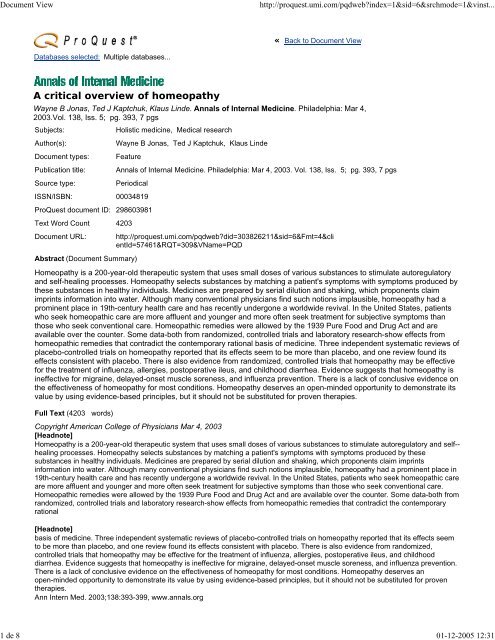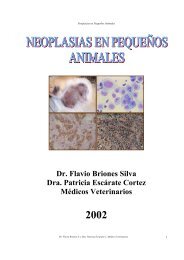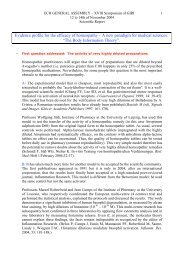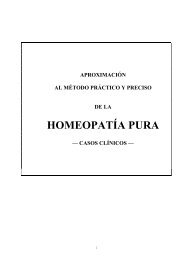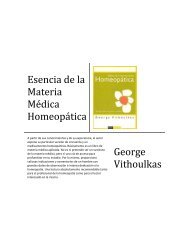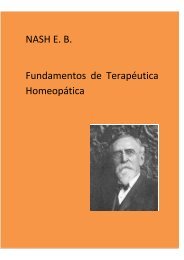A Critical Overview Of Homeopathy
A Critical Overview Of Homeopathy
A Critical Overview Of Homeopathy
Create successful ePaper yourself
Turn your PDF publications into a flip-book with our unique Google optimized e-Paper software.
Document Viewhttp://proquest.umi.com/pqdweb?index=1&sid=6&srchmode=1&vinst...1 de 8 01-12-2005 12:31Databases selected: Multiple databases...« Back to Document ViewA critical overview of homeopathyWayne B Jonas, Ted J Kaptchuk, Klaus Linde. Annals of Internal Medicine. Philadelphia: Mar 4,2003.Vol. 138, Iss. 5; pg. 393, 7 pgsSubjects:Holistic medicine, Medical researchAuthor(s):Wayne B Jonas, Ted J Kaptchuk, Klaus LindeDocument types: FeaturePublication title: Annals of Internal Medicine. Philadelphia: Mar 4, 2003. Vol. 138, Iss. 5; pg. 393, 7 pgsSource type:PeriodicalISSN/ISBN: 00034819ProQuest document ID: 298603981Text Word Count 4203Document URL: http://proquest.umi.com/pqdweb?did=303826211&sid=6&Fmt=4&clientId=57461&RQT=309&VName=PQDAbstract (Document Summary)<strong>Homeopathy</strong> is a 200-year-old therapeutic system that uses small doses of various substances to stimulate autoregulatoryand self-healing processes. <strong>Homeopathy</strong> selects substances by matching a patient's symptoms with symptoms produced bythese substances in healthy individuals. Medicines are prepared by serial dilution and shaking, which proponents claimimprints information into water. Although many conventional physicians find such notions implausible, homeopathy had aprominent place in 19th-century health care and has recently undergone a worldwide revival. In the United States, patientswho seek homeopathic care are more affluent and younger and more often seek treatment for subjective symptoms thanthose who seek conventional care. Homeopathic remedies were allowed by the 1939 Pure Food and Drug Act and areavailable over the counter. Some data-both from randomized, controlled trials and laboratory research-show effects fromhomeopathic remedies that contradict the contemporary rational basis of medicine. Three independent systematic reviews ofplacebo-controlled trials on homeopathy reported that its effects seem to be more than placebo, and one review found itseffects consistent with placebo. There is also evidence from randomized, controlled trials that homeopathy may be effectivefor the treatment of influenza, allergies, postoperative ileus, and childhood diarrhea. Evidence suggests that homeopathy isineffective for migraine, delayed-onset muscle soreness, and influenza prevention. There is a lack of conclusive evidence onthe effectiveness of homeopathy for most conditions. <strong>Homeopathy</strong> deserves an open-minded opportunity to demonstrate itsvalue by using evidence-based principles, but it should not be substituted for proven therapies.Full Text (4203 words)Copyright American College of Physicians Mar 4, 2003[Headnote]<strong>Homeopathy</strong> is a 200-year-old therapeutic system that uses small doses of various substances to stimulate autoregulatory and self--healing processes. <strong>Homeopathy</strong> selects substances by matching a patient's symptoms with symptoms produced by thesesubstances in healthy individuals. Medicines are prepared by serial dilution and shaking, which proponents claim imprintsinformation into water. Although many conventional physicians find such notions implausible, homeopathy had a prominent place in19th-century health care and has recently undergone a worldwide revival. In the United States, patients who seek homeopathic careare more affluent and younger and more often seek treatment for subjective symptoms than those who seek conventional care.Homeopathic remedies were allowed by the 1939 Pure Food and Drug Act and are available over the counter. Some data-both fromrandomized, controlled trials and laboratory research-show effects from homeopathic remedies that contradict the contemporaryrational[Headnote]basis of medicine. Three independent systematic reviews of placebo-controlled trials on homeopathy reported that its effects seemto be more than placebo, and one review found its effects consistent with placebo. There is also evidence from randomized,controlled trials that homeopathy may be effective for the treatment of influenza, allergies, postoperative ileus, and childhooddiarrhea. Evidence suggests that homeopathy is ineffective for migraine, delayed-onset muscle soreness, and influenza prevention.There is a lack of conclusive evidence on the effectiveness of homeopathy for most conditions. <strong>Homeopathy</strong> deserves anopen-minded opportunity to demonstrate its value by using evidence-based principles, but it should not be substituted for proventherapies.Ann Intern Med. 2003;138:393-399, www.annals.org
Document Viewhttp://proquest.umi.com/pqdweb?index=1&sid=6&srchmode=1&vinst...3 de 8 01-12-2005 12:31formed a year after the American Institute of <strong>Homeopathy</strong>, partly to combat such "irregulars" (10). In 1852, the predecessorjournal of The New England Journal of Medicine proclaimed that homeopathy is "a cheat" with little advantage "over theIndian meal and table salt (placebos) of an earlier date and worthy of the disembodied spirits in the Paradise of Odin, wherethe inhabitants feed on shadows" (11,12). Foreshadowing contemporary debates, homeopaths responded with statistics andhelped pioneer comparative quantitative information and large-scale comparative trials (13-16). For example, during thecholera epidemic of 1854, homeopathic hospitals had dramatically lower mortality rates than allopathic institutions (17).Obviously, such outcomes could have many explanations, such as homeopaths' eschewing violent purgatives. Orthodoxphysicians criticized the quality of the data and questioned the reliability of any "complex" mathematical method thatportrayed homeopathy favorably (15,17).Toward the end of the century, a rapprochement between homeopaths and conventional physicians gradually unfolded.Exchanges took place: Homeopaths adopted new orthodox treatments, such as diphtheria antitoxin, while allopathsborrowed homeopathic remedies, such as nitroglycerin (18,19). In 1903, after long antagonism, the AMA-in need ofhomeopathic referrals for its newly proliferating medical specialties and allies to oppose emerging alternatives, such asosteopathy-invited homeopaths to join. This merger greatly accelerated the assimilation and demise of homeopathy (20,21).A new revival of homeopathy in the United States began in the 1960s and 1970s and is closely allied to interpretations ofhomeopathy that emphasize "high" potencies and psychological symptomology (22). The resurgence continues: The numberof patients using homeopathy in the United States is estimated to have increased 500% in the last 7 years, most involvingself-treatment with overthe-counter remedies (23).HOMEOPATHIC PRACTICEPatterns of PracticeIn the United States, patients seen by homeopathic physicians tend to be more affluent, more frequently be white, presentmore subjective symptoms, and be younger than patients seen by conventional physicians (24). Conventional physicians seealmost twice the number of patients older than 65 years of age, spend less than half as much time with each patient (12minutes vs. 30 minutes), and order more tests than homeopathic physicians (24). In the United States, much homeopathicpractice is integrated with conventional care because homeopathic physicians use conventional medications in a quarter ofthe patients they see (28% for homeopathic physicians vs. 69% for conventional physicians) (24). Table 1 compares the 10most common diagnoses seen by homeopathic and conventional primary care physicians.Patients seeking homeopathic care are liable to find various approaches depending on their clinician's philosophy andtraining. "Classical" homeopathy usually involves a detailed history (often lasting over an hour) and infrequent doses (everymonth or less) of a single remedy. The total patient response is followed and evaluated for specific patterns of improvementcharacteristic of a healing response. "Clinical" homeopathy uses combinations of remedies to "cover" the symptomaticvariations of a clinical condition, similar to conventional drug treatment. The American Institute of <strong>Homeopathy</strong> is the oldestorganization for licensed health care professionals, and there are licensing organizations for chiropractors, naturopaths, and,more recently, "professional" homeopaths who do not hold medical degrees. While the classical approach to homeopathy isfairly standardized, some practitioners use electronic instruments, electroacupuncture devices, pendulums, their ownintuition, or metaphysical principles to select remedies, with little regulatory oversight of these approaches. This presents aconfusing array of approaches for patients under the term "homeopathy" (1). In addition, many patients self-prescribehomeopathic remedies and never consult a practitioner.Enlarge 200%Enlarge 400%Table 2.Adverse Events and Drug LabelingThe Food, Drug, and Cosmetic Act of 1939 allowed homeopathic medicines to be on the market. These medicines areclassified as safe for over-the-counter use. The U.S. Homeopathic Pharmacopoeia Convention meets regularly withmembers of the Food and Drug Administration to set standards for good laboratory practices and assure quality anduncontaminated production of homeopathic medicines. Dilutions in a ratio of 1:10 are labeled with an X or a D (for decimal),and those diluted in a ratio of 1:100 are labeled with a C (for centesimal). Thus, 6X (or 6D) has been diluted 1:10 six times
Document Viewhttp://proquest.umi.com/pqdweb?index=1&sid=6&srchmode=1&vinst...4 de 8 01-12-2005 12:31and 6C has been diluted 1:100 six times. Because of the small doses, almost all authorities assume that homeopathy is safeand will not interact with conventional drugs as long as patients also receive good conventional care. However, the benignnature of high dilutions should not be assumed without systematic investigation. Adverse effects have been reported withhomeopathy in both the clinic and the laboratory (25,26).DOES HOMEOPATHY WORK?The evidence for homeopathy's effectiveness includes three areas of research: 1) general comparisons of homeopathicremedies and placebos; 2) studies of homeopathy's effectiveness for particular clinical conditions; and 3) studies looking forbiological effects from potencies, especially ultra-high dilutions. Data for general effectiveness include systematic reviewsand meta-analyses of randomized, placebo-controlled trials. Some investigators believe that it is reasonable to combine trialsof different populations, interventions, and outcome measures when the question is whether comparison groups(homeopathic and placebo) are generally different (27), but others are skeptical of such approaches. Data for theeffectiveness of homeopathy for specific clinical conditions require homogeneous sets of studies with similar populations,diagnoses, and outcomes. Data on the biological effects of high dilutions are investigated with laboratory studies undercarefully controlled conditions (5). We orient the reader to these three types of evidence.Is the Homeopathic Remedy More Effective than Placebo?Four comprehensive, independent systematic reviews or meta-analyses have examined the question of whetherhomeopathic therapies behave like placebo in randomized, placebo-controlled trials (Table 2). These have comprehensivelysearched for all clinical trials and have used standard methods for quality evaluation and analysis of clinical trials. Thesereviews have found that, overall, the quality of clinical research in homeopathy is low. When only high-- quality studies havebeen selected for analysis (such as those with adequate randomization, blinding, sample size, and other methodologiccriteria that limit bias), a surprising number show positive results. For example, Kleijnen and colleagues (28) did a detailedquality evaluation of 60 homeopathic clinical trials and concluded that they "would be ready to accept that homeopathy canbe efficacious, if only the mechanism of action were more plausible." Linde and colleagues (29) reviewed 119placebo-controlled trials of homeopathy and evaluated them with an established quality scale for clinical research (the Jadadscale [34]) and a rigorous internal validity scale that examined detailed trial characteristics known to bias results. Multiplesubset and sensitivity analyses on many quality variables reduced but did not eliminate an effect in favor of homeopathy.One could eventually eliminate the effect in favor of homeopathy by applying combinations of unusually selective criteria(such as picking a few of the very best studies and simultaneously adjusting their results for both small sample size andpresumed publication bias), thereby decreasing the number of studies included (30, 31). There are other reviews of theclinical homeopathic literature, but these have not been comprehensive, did not use acceptable systematic review methods,or focused on a subtype of homeopathic practice (32, 33, 35) (Table 2). Unfortunately, even the best systematic reviewscannot disentangle components of bias that may exist in small trials, nor can they rule out that true effects may be obscuredwith pooling of heterogeneous studies (36, 37), thereby making it impossible to draw definitive conclusions.Enlarge 200%Enlarge 400%Table 3.
Document Viewhttp://proquest.umi.com/pqdweb?index=1&sid=6&srchmode=1&vinst...5 de 8 01-12-2005 12:31Is <strong>Homeopathy</strong> Effective for Particular Conditions?Patients and most clinicians want to know whether a treatment works for a particular condition, not whether homeopathy ismore effective than placebo in general. Several series of randomized, placebo-controlled trials have been done on singleconditions with homeopathy and have been reviewed by using good-quality criteria. These studies provide evidence thatclassical homeopathy does not prevent migraine (38) and that the homeopathic remedy Arnica montana does not alleviatedelayed-onset muscle soreness after exercise (39). The quality reviews on the effects of Arnica montana for postoperativerecovery are mixed (40,41). Some evidence shows that the homeopathic preparation Oscillococcinum is effective for thetreatment of influenza but not for its prevention (42) and that the remedy Galphimia glauca is efficacious for the treatment ofallergic rhinitis (43). In several other conditions, most notably postoperative ileus (44), asthma (45), and arthritis (46), theevidence from controlled trials is inconclusive; independent replications have not been attempted or the results of trials aremixed.Recently, Taylor and colleagues (47) published the fourth in a series of high-quality, double-blind, placebocontrolled trials ofhomeopathic immunotherapy. In these trials, patients with allergic rhinitis or asthma were given homeopathic (seriallyagitated) dilutions of their primary allergen or a placebo after a 2-week placebo run-in phase. Visual analogue scales used tomeasure symptomatic change have consistently shown greater improvement in the homeopathically treated groups (47). Alarger study using a similar protocol did not reproduce this clinical effect, although it reported immunologic findings withhomeopathic immunotherapy that were different from those seen with placebo (48). In a series of three high-qualitydouble-blind, placebo-controlled studies on childhood diarrhea, Jacobs and colleagues (49, 50) reported that classicalhomeopathy reduced the duration of loose stools by about 0.7 day. Double-blind randomized, placebo-controlled trials on afew other conditions have also been published (Table 3).Do Ultra-High Dilutions Produce Effects in the Laboratory?Clinical trials are less sensitive for determining whether ultra-high dilutions have specific effects than laboratory research,where more rigorously controlled conditions are possible. The publication of laboratory investigations of ultra-high dilutionshas produced considerable controversy and mixed results on attempted replication (52-54). Still, unusual effects of ultra-highdilutions in rigorous laboratory studies continue to be reported (5559). Multiple independent replications of this research havenot yet been done because there are few investigators in the field (60). Future research should focus on simple clinical orlaboratory models that can be easily attempted by multiple investigators. In addition, better data are needed to examine theuse and effects of homeopathy by the public and in actual practice (5,29,61).CONCLUSIONS<strong>Homeopathy</strong> is an alternative therapeutic system based on the "Principle of Similars" and the use of "minimum" doses.<strong>Homeopathy</strong> was a prominent component of 19th-- century health care and recently has undergone a revival in the UnitedStates and around the world. Despite skepticism about the plausibility of homeopathy, some randomized, placebo-controlledtrials and laboratory research report unexpected effects of homeopathic medicines. However, the evidence on theeffectiveness of homeopathy for specific clinical conditions is scant, is of uneven quality, and is generally poorer quality thanresearch done in allopathic medicine (61). More and better research is needed, unobstructed by belief or disbelief in thesystem (62). Until homeopathy is better understood, it is important that physicians be open-minded about homeopathy'spossible value and maintain communication with patients who use it. As in all of medicine, physicians must know how toprevent patients from abandoning effective therapy for serious diseases and when to permit safe therapies even if only fortheir nonspecific value.[Sidebar]From Samueli Institute for Information Biology and Uniformed Services University of the Health Sciences, Bethesda, Maryland;Harvard Medical School, Boston, Massachusetts; and Centre for Complementary Medicine Research, Technische Universitat,MUnchen, Germany.[Sidebar]Disclaimer: The views, opinions, and assertions expressed in this article are those of the authors and do not reflect official policy ofthe Department of Defense, the Department of Health and Human Services, or the U.S. Government.[Sidebar]Acknowledgments: The authors thank Cindy Crawford for her assistance in preparation of this manuscript and Ronald A. Chez, MD,for his editorial review.[Sidebar]Grant Support: In part by the Samueli Institute for Information Biology and National Institutes of Health grants (AT00178-01 andAT00270-- 01).[Reference]References
Document Viewhttp://proquest.umi.com/pqdweb?index=1&sid=6&srchmode=1&vinst...6 de 8 01-12-2005 12:31[Reference]1. Jones WB, Jacobs J. Healing with <strong>Homeopathy</strong>: The Complete Guide. New York: Warner; 1996.2. Hahnemann S. Organon of Medicine. Los Angeles: JP Tarcher; 1982.3. Maddox J, Randi J, Stewart WW. "High-dilution" experiments a delusion. Nature. 1988;334:287-91. [PMID: 2455869]4. Kent JT. What is homoeopathy? Homoeopathic Physician. 1885;5:346-51.5. Linde K, Jones WB. Evaluating complementary and alternative medicine: the balance of rigor and relevance. In: Jones WB, LevinJS, eds. Essentials of Complementary and Alternative Medicine. Philadelphia: Lippincott; 1999:57-71.6. Haehl R. Samuel Hahnemann: His Life and Work. London: Homeopathic Publishine: 1922.[Reference]7. Rothstein WG. American Physicians in the 19th Century. Baltimore: Johns Hopkins Univ Pr; 1992.8. Roberts WE. Orthodoxy vs. homeopathy: ironic developments following the Flexner Report at the Ohio State University. Bull HistMed. 1986;60:73-87. [PMID: 3516284]9. Persons S. The decline of homeopathy-the University of Iowa, 1876-1919. Bull Hist Med. 1991;65:74-87. [PMID: 2021694]10. Coulter HL Divided Legacy: The Conflict Between <strong>Homeopathy</strong> and the American Medical Association. vol 3. Berkeley, CA:North Atlantic Books; 1981.11. Leland PW. Empiricism and its causes. Boston Medical Surgery Journal. 1852;47:283-90.12. Parker WW. Was Hahnemann insane? JAMA. 1886:7-9.13. Joslin BE Lecture on cholera. Eclectic Medical Journal. 1849;8:363-8.14. Kaptchuk TJ. Intentional ignorance: a history of blind assessment and placebo controls in medicine. Bull Hist Med.1998;72:389-433. [PMID: 9780448115. Kaptchuk TJ. When does unbiased become biased? The dilemma of homeopathic proving and modern research methods.British Journal of <strong>Homeopathy</strong>. 1996;85:237-47.16. Cassedy J. American Medicine and Statistical Thinking, 1800-1860. Cambridge: Harvard Univ Pr, 1984.17. Leary B. Cholera 1854: update. British Homeopathic Journal. 1994;83:11721.18. Fye WB. Nitroglycerin: a homeopathic remedy. Circulation. 1986;73:21-9 [PMID: 2866851]19. Nicholls PA. <strong>Homeopathy</strong> and the Medical Profession. London: Croon Helm; 1988.20. Ernst E, Kaptchuk TJ. <strong>Homeopathy</strong> revisited. Arch Intern Med. 1996;156 2162-4. [PMID: 8885813]21. Rogers N. An Alternative Path: The Making and Remaking of Hahnemant Medical College and Hospital in Philadelphia. NewBrunswick, NJ: Rutger Univ Pr; 1998.22. Mukherjee JK The biological background of Hahnemannians vital force Hahn Glean. 1964;31:163-8.23. Eisenberg DM, Davis RB, Ettner SL, Appel S, Wilkey S, Van Rompay M et al. Trends in alternative medicine use in the UnitedStates, 1990-1997: result of a follow-up national survey. JAMA. 1998;280:1569-75. [PMID: 9820257] 24. Jacobs J, Chapman EH,Crothers D. Patient characteristics and practic[Reference]patterns of physicians using homeopathy. Arch Fam Med. 1998;7:537-40. [PMID: 9821827]25. How to use high potencies. Homoeopathic Physician. 1882;2:73.26. Jones WB, Ernst E. The safety of homeopathy. In: Jones WB, Levin J, eds. Essentials of Complementary and AlternativeMedicine. Philadelphia: Lippincott Williams & Wilkins; 1999:167-71.27. Hrobjartsson A, Gotzsche PC. Is the placebo powerless? An analysis of clinical trials comparing placebo with no treatment. NEngl J Med. 2001;344: 1594-602. [PMID: 11372012]28. Kleijnen J, Knipschild P, ter Riet G. Clinical trials of homoeopathy. BMJ. 1991;302:316-23. [PMID: 1825800129. Linde K, Clausius N, Ramirez G, Melchart D, Eitel F, Hedges LV, et al. Are the clinical effects of homeopathy placebo effects? Ameta-analysis of placebocontrolled trials. Lancet. 1997;350:834-43. [PMID: 9310601]30. Linde K, Melchart D. Randomized controlled trials of individualized homeopathy: a state-of-the-art review. J Altem ComplementMed. 1998;4:371-88. [PMID: 9884175][Reference]31. Ernst E. Classical homoeopathy versus conventional treatments: a systematic review. Perfusion. 1999;12:13-5.32. Cucherat M, Haugh MC, Gooch M, Boissel JP. Evidence of clinical efficacy of homeopathy. A meta-analysis of clinical trials.HMRAG. Homeopathic Medicines Research Advisory Group. Eur J Clin Pharmacol. 2000;56:27-33. [PMID: 10853874]33. Walach H. Unspezifiche Therapie-Effekte. Das Beispiel Homoopathie [PhD thesis]. Freiburg, Germany: Psychologische Institut,Albert-Ludwigs-Universitat Freiburg; 1997.34. Jadad AR, McQuay HJ. Meta-analyses to evaluate analgesic interventions: a systematic qualitative review of their methodology.J Clin Epidemiol. 1996;49: 235-43. [PMID: 8606325]35. Egger M, Juni P, Holenstein F, Sterne JA. Are the Clinical Effects of <strong>Homeopathy</strong> Bias Effects? Bristol, United Kingdom:Department of Social Medicine, University of Bristol; 2001.36. Lewin D. Meta-analysis: a new standard or clinical fool's gold. Journal of NIH Research. 1996;8:30-1.37. Linde K, Willich SN. How objective are systematic reviews? Differences between reviews on complementary medicine. J R SocMed. 2003;96:17-22. [PMID: 12519797]38. Ernst E. Homeopathic prophylaxis of headaches and migraine? A systematic review. J Pain Symptom Manage. 1999;18:353-7.[PMID: 10584459]39. Ernst E. Does homeopathic Arnica montana reduce delayed onset muscle soreness? A meta-analysis. Perfusion.1997;11:29-35.
Document Viewhttp://proquest.umi.com/pqdweb?index=1&sid=6&srchmode=1&vinst...7 de 8 01-12-2005 12:3140. Ernst E, Pittler MH. Efficacy of homeopathic amica: a systematic review of placebo-controlled clinical trials. Arch Surg.1998;133:1187-90. [PMID: 9820349]41. Ludtke R, Wilkens J. Klinische Wirksamkeitsstudien zu Arnica in hom6opathischen Zubereitungen. In: Albrecht H, Friihwald M,eds. Jahrbuch der Karl and Veronica Carstens-Stiftung, Band 5 (1998). Essen, Germany: KVC-Verlag; 1999:97-112.42. Vickers AJ, Smith C. Homoeopathic Oscillococcinum for preventing and treating influenza and influenza-like syndromes.Cochrane Database Syst Rev. 2000;CD001957. [PMID: 10796675]43. Wiesenauer M, Ludtke IL A meta-analysis of the homeopathic treatment of pollinosis with Galphimia glauca. ForschKomplementarmed. 1996;3:230-6.44. Barnes J, Resch KL, Ernst E. <strong>Homeopathy</strong> for postoperative ileus? A metaanalysis. J Clin Gastroenterol. 1997;25:628-33.[PMID: 9451677]45. Linde K, Jobst KA. <strong>Homeopathy</strong> for chronic asthma. Cochrane Database Syst Rev. 2000;CDO00353. [PMID: 10796532]46. Jonas WB, Linde K, Ramirez G. <strong>Homeopathy</strong> and rheumatic disease. Rheum Dis Clin North Am. 2000;26:117-23, x. [PMID:10680199]47. Taylor MA, Reilly D, Llewellyn-Jones RH, McSharry C, Aitchison TC. Randomised controlled trial of homoeopathy versusplacebo in perennial allergic rhinitis with overview of four trial series. BMJ. 2000;321:471-6. [PMID: 10948025]48. Lewith GT, Watkins AD, Hyland ME, Shaw S, Broomfield JA, Dolan G, et al. Use of ultramolecular potencies of allergen to treatasthmatic people allergic to house dust mite: double blind randomised controlled clinical trial. BMJ. 2002;[Reference]324:520-3. [PMID: 11872551]49. Jacobs J, Jimenez LM, Gloyd SS, Gale JL, Crothers D. Treatment of acute childhood diarrhea with homeopathic medicine: arandomized clinical trial in Nicaragua. Pediatrics. 1994;93:719-25. [PMID: 8165068]50. Jacobs J, Jonas WB, Jimenez-Perez M, Crothers D. <strong>Homeopathy</strong> for childhood diarrhea: combined results and meta-analysisfrom three randomized controlled trials. Pediatr Infect Dis. 2003; [In press].51. Jacobs JW, Rasker JJ, Van Riel PL, Gribnau FW, van de Putte LB. [Alternative treatment methods in rheumatic diseases; aliterature review]. Ned Tijdschr Geneeskd. 1991;135:317-22. [PMID: 2008219]52. Davenas E, Beauvais F, Amara J, Oberbattm M, Robinzon B, Miadonna A, et al. Human basophil degranulation triggered byvery dilute antiserum against IgE. Nature. 1988;333:816-8. [PMID: 2455231]53. Hirst SJ, Hayes NA, Burridge J, Pearce FL Foreman JC. Human basophil degranulation is not triggered by very dilute antiserumagainst human IgE. Nature. 1993;366:525-7. [PMID: 8255290]54. Ovelgonne JH, Bol AW, Hop WC, van Wijk IL Mechanical agitation of very dilute antiserum against IgE has no effect on basophilstaining properties. Experientia. 1992;48:504-8. [PMID: 1376282]55. Jonas WB, Lin Y, Williams A, Tortella R, Tuma R. Treatment of experimental stroke with low-dose glutamate and homeopathicArnica Montana. Per[Reference]fusion. 1999;12:452-62.56. Jones WB, Dinner DK Protection of mice from tularemia infection with ultra-low, serial agitated dilutions prepared from Ftu/is-infected tissue. Journal of Scientific Exploration. 2000;14:35-52.57. Jones W, Lin Y, Tortella F. Neuroprotection from glutamate toxicity with ultra-low dose glutamate. Neuroreports, 2001;12:335-9.[PMID: 11209946] 58. Belon P, Cumps J, Ennis M, Mannaioni PF, Sainte-Laudy J, Roberfroid M, et al. Inhibition of human basophildegranulation by successive histamine dilutions: results of a European multi-centre trial. Inflamm Res. 1999;48 Suppl 1:517-8.[PMID: 10350142]59. Linde K Jones WB, Melchart D, Worka F, Wagner H, Eitel F. <strong>Critical</strong> review and meta-analysis of serial agitated dilutions inexperimental toxicology. Hum Exp Toxicol. 1994;13:481-92. [PMID: 7917505]60. Vickers AJ. Independent replication of pre-clinical research in homeopathy: a systematic review. Forsch Komplementarmed.1999;6:311-20. [PMID: 10649002]61. Jones WB, Anderson RL, Crawford CC, Lyons JS. A systematic review of the quality of homeopathic clinical trials. BMCComplement Altern Med. 2001; 1:12. [PMID: 11801202]62. Jones WB. The homeopathy debate [Letter]. J Altern Complement Med. 2000;6:213-5. [PMID: 10890328][Author Affiliation]Wayne B. Jonas, MD; Ted J. Kaptchuk, OMD; and Klaus Linde, MD[Author Affiliation]Requests for Single Reprints: Wayne B. Jonas, MD, Samueli Institute, 121 South Saint Asaph Street, Suite 200, Alexandria, VA22314; e-mail, wjonas@siib.org.Current author addresses are available at www.annals.org.Copyright © 2005 ProQuest Information and Learning Company. All rights reserved. Terms and ConditionsText-only interface
Document Viewhttp://proquest.umi.com/pqdweb?index=1&sid=6&srchmode=1&vinst...8 de 8 01-12-2005 12:31


